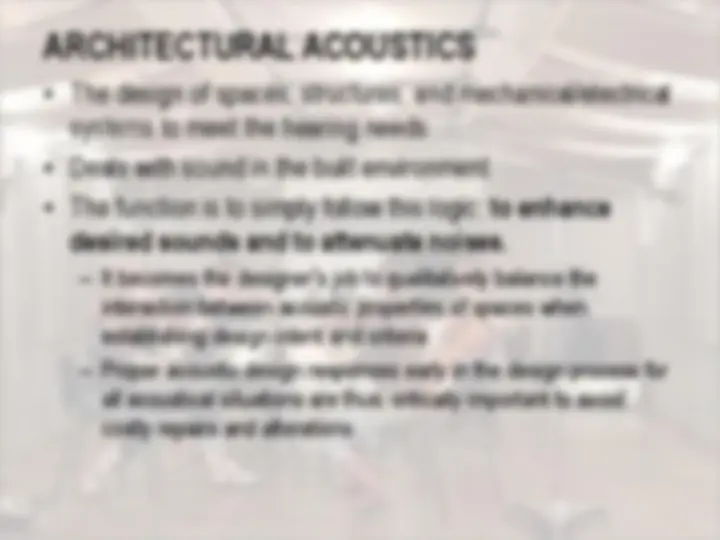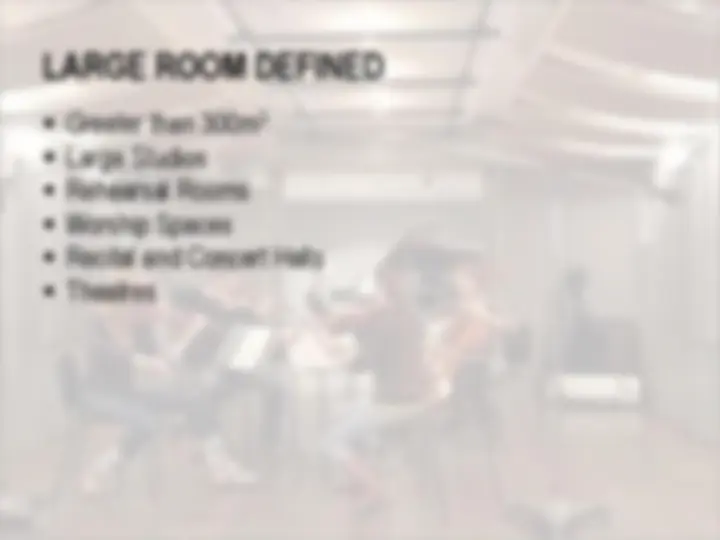





















































Study with the several resources on Docsity

Earn points by helping other students or get them with a premium plan


Prepare for your exams
Study with the several resources on Docsity

Earn points to download
Earn points by helping other students or get them with a premium plan
Community
Ask the community for help and clear up your study doubts
Discover the best universities in your country according to Docsity users
Free resources
Download our free guides on studying techniques, anxiety management strategies, and thesis advice from Docsity tutors
These are the current trends in innovation in Architecture
Typology: Study Guides, Projects, Research
1 / 59

This page cannot be seen from the preview
Don't miss anything!




















































Lecture 2 - ROOM ACOUSTICS
The architect deals always with the human senses when designing a building’s environment. The acoustical environment in and around the buildings is influenced by factors associated with the building planning-design- construction process Selection of site Location of the buildings on the site Arrangement of spaces within the building Materials and construction elements that shape the finished spaces
BRANCHES OF ACOUSTICS
Engineering Acoustics deals with the development of devices to generate (e.g., loudspeakers), record (e.g., microphones) and analyze (e.g., frequency analyzers) sound of all kinds. The field of sound production, recording and reproduction, with all its attendant electronics and measuring instruments, is an important part of engineering acoustics.
Musical acoustics considers the workings of traditional, experimental and electronic musical instruments. The interaction of musicians, instruments, listeners and performance spaces means that many branches of acoustics influence work in this field.
Bioacoustics studies all aspects of acoustic behaviour in animals and biological media in general. This field includes such topics as sound production by animals, biosonar, sound reception by animals, effects of noise on animals and medical diagnostics using acoustics, especially ultrasonics.
Architectural Acoustics is concerned with sound in buildings. One aspect of this field is the control of sound within rooms to maximize the acceptability of music or intelligibility of speech. This branch of architectural acoustics deals with sound in lecture or concert halls, meeting rooms and classrooms. − Sound production, by one or more live players, vocalists or lecturers, whether assisted by loudspeakers or not, is greatly affected by the character of the room in which it takes place. − The correct choice and placement of sound-absorbing and sound- reflecting materials in a room and the level of noise in it are critical to obtaining an acceptable space. − Properly placed reflectors can direct the sound to where it will do most good. Properly placed sound-absorbing materials will prevent reflections that might cause unpleasant echoes or cause sounds to interfere and cancel each other out.
Room acoustics − involves the design of the interior of buildings to project properly diffused sound at appropriate levels and with appropriate aesthetic qualities for music and adequate intelligibility for speech. Noise control or noise management − involves the reduction and control of noise between a potentially disturbing sound source and a listener. Sound isolation − involves site consideration, location of activities within the building, construction of barriers, background sound levels in coordination with room acoustics Sound reinforcement and enhancement systems − use electronic equipment to improve the quality of sounds heard in rooms.